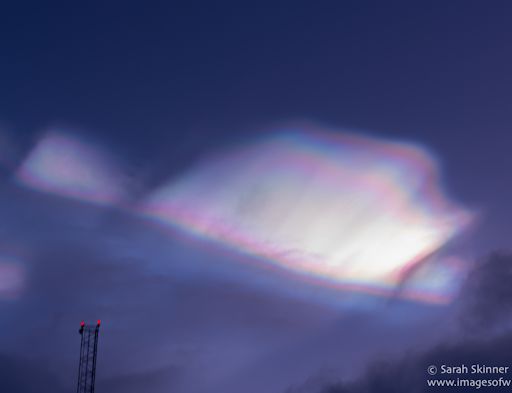
"Just as I was heading out to de-ice the car on Dec. 14th, I looked up and noticed the most incredible cloud formation," says Skinner. "At the same time, an excited text came through from my boss, aurora tour guide Chad Blakley, who having lived here for many years has seen this only once or twice and explained to an Arctic newbie like me how rare these formations really are."
Also known as "nacreous" or "mother of pearl" clouds, the icy structures form in the lower stratosphere when temperatures drop to around minus 85ºC. Sunlight shining through tiny ice particles ~10µm across produce the characteristic bright iridescent colors by diffraction and interference. Once thought to be mere curiosities, some PMCs are now known to be associated with the destruction of ozone.
"Nacreous clouds far outshine and have much more vivid colours than ordinary iridescent clouds, which are very much poor relations and seen frequently all over the world," writes atmospheric optics expert Les Cowley. "Once seen they are never forgotten."
Bron:http://www.spaceweather.com/ | Gewijzigd: 17 december 2015, 18:48 uur, door Justin
UPDATE:
For the second day in a row, sky watchers are reporting an outbreak of polar stratospheric clouds (PSCs) around the Arctic Circle. Unlike normal grey-white clouds, which hug Earth's surface at altitudes of only 5 to 10 km, PSCs float through the stratosphere (25 km) and they are fantastically colorful. Truls Tiller photographed these over Tromsø, Norway, on Dec. 16th: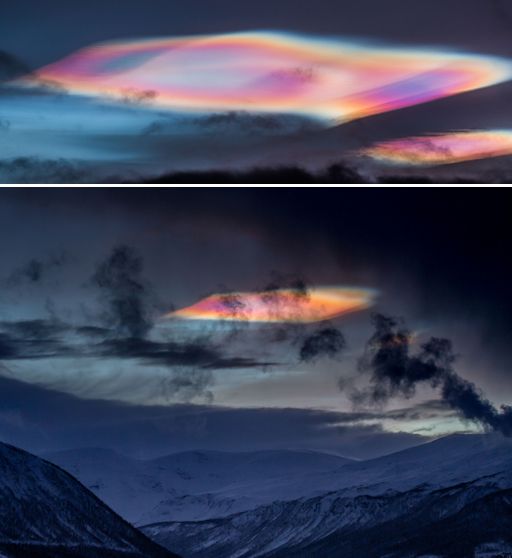
photo Truls Tiller
"Here the sun is gone for now," says Tiller, "but this beautiful view makes the winter darkness nice to be in as well. The picture was taken at 10.30 am, in the middle of the 'day.'"
Also known as "nacreous" or "mother of pearl" clouds, the icy structures form in the lower stratosphere when temperatures drop to around minus 85ºC. High-altitude sunlight shining through tiny ice particles ~10µm across produce the characteristic bright iridescent colors by diffraction and interference. Once thought to be mere curiosities, some PSCs are now known to be associated with the destruction of ozone.
"Nacreous clouds far outshine and have much more vivid colours than ordinary iridescent clouds, which are very much poor relations and seen frequently all over the world," writes atmospheric optics expert Les Cowley. "Once seen they are never forgotten."
Bron:http://www.spaceweather.com/ | Gewijzigd: 31 januari 2017, 15:52 uur, door Joyce.s
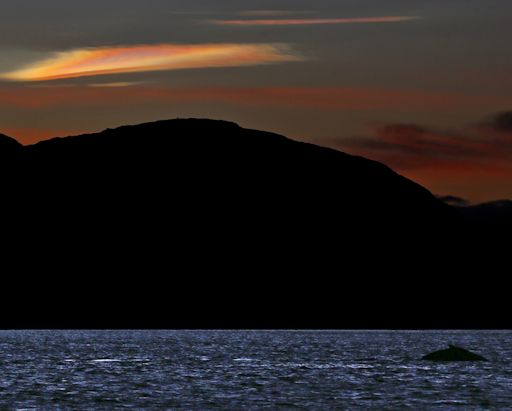
photo Marcus Åhlund
"Look carefully at the picture," says Åhlund. "The whale is there, too!"
Lately, Arctic sky watchers have been seeing a lot of PSCs. Also known as "nacreous" or "mother of pearl" clouds, icy PSCs form in the lower stratosphere when temperatures drop to around minus 85ºC. That's how cold it has to be for ice to crystalize in the stratosphere. High-altitude sunlight shining through tiny ice particles ~10µm across produce the characteristic bright iridescent colors by diffraction and interference. Once thought to be mere curiosities, some PSCs are now known to be associated with the destruction of ozone.
"Polar stratospheric clouds far outshine and have much more vivid colours thanordinary iridescent clouds, which are very much poor relations and seen frequently all over the world," writes atmospheric optics expert Les Cowley. "Once seen they are never forgotten."
The best time to look for PSCs is just before sunrise or right after sunset, when the ground is dark but the upper atmosphere is still illuminated by sunlight.
Bron:http://www.spaceweather.com/ | Gewijzigd: 31 januari 2017, 15:52 uur, door Joyce.s
An outbreak of polar stratospheric clouds (PSCs) is underway--but not around the poles. Sky watchers are reporting the beautifully-colored clouds over the UK. David Porter photographed this specimen on Jan. 29th from his home in Turriff, Aberdeenshire:

photo David Porter
"I saw it just before sunrise," says Porter. "The cloud was colorful and highly reflective." Rob Powell of Stonehaven, Scotland, saw them, too. "It was a lovely sunrise," he says.
Also known as "nacreous" or "mother of pearl" clouds, icy PSCs form in the lower stratosphere when temperatures drop to around minus 85ºC. High-altitude sunlight shining through tiny ice particles ~10µm wide produce bright iridescent colors by diffraction and interference. Once thought to be mere curiosities, some PSCs are now known to be associated with the destruction of ozone.
"Nacreous clouds far outshine and have much more vivid colours than ordinary iridescent clouds, which are very much poor relations and seen frequently all over the world," writes atmospheric optics expert Les Cowley. "Once seen they are never forgotten."
Bron: http://www.spaceweather.com/ | Gewijzigd: 31 januari 2017, 15:53 uur, door Joyce.s
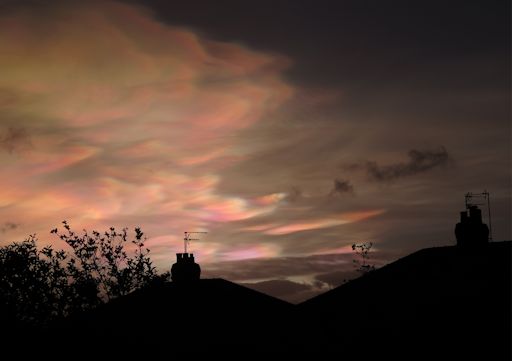
photo Sean Crane
This is the second day in a row that I have left my early morning bath prematurely to take photos from the garden," says Crane.
These fantasticaly-colored clouds are floating more than 80,000 feet above Earth's surface. Normally, the thin air up there is crystal clear. Not this week. Water molecules are crystalizing in the lower stratosphere and the resulting ice crystals are assembling into polar stratospheric clouds (PSCs).
Also known as "nacreous" clouds, PSCs form in the lower stratosphere when temperatures drop to a staggeringly-cold -85ºC. High-altitude sunlight shining through tiny ice particles ~10µm wide produce bright iridescent colors by diffraction and interference.
Because these clouds require extreme cold, they are most often seen around the Arctic Circle. In recent days, however, they have been spotted as far south as the UK. Indeed, a "stratospheric cloud event" appears to be underway. Monitor the gallery for more sightings:
bron: http://www.spaceweather.com/ | Gewijzigd: 31 januari 2017, 15:54 uur, door Joyce.s
For the past week, sky watchers in the UK have witnessed a rare apparition of polar stratospheric clouds (PSCs). Normally restricted to the Arctic Circle, the fantastically colorful clouds have appeared over the British Isles almost every day since Jan. 31st. Colin Fraser photographed the display over Edinburgh, Scotland, on Feb. 2nd:
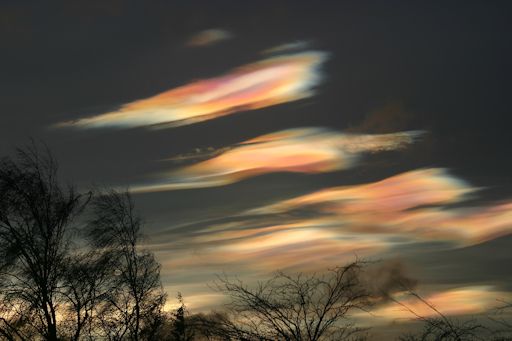
photo Colin Fraser
PSCs form in the lower stratosphere when temperatures drop to a staggeringly-cold -85ºC. High-altitude sunlight shining through tiny ice particles ~10µm wide produce bright iridescent colors by diffraction and interference.
But there is more to PSCs than ice. Some polar stratospheric clouds contain very small droplets of naturally occurring nitric and sulphuric acids. These droplets destroy ozone. Indeed, atmospheric optics expert Les Cowley points out that a temporary ozone hole has formed over Ireland and the UK. It is the blue patch in this Feb. 1st ozone map from NASA's Arctic Ozone Watch:
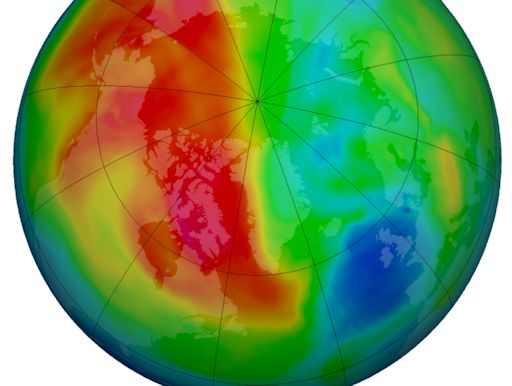
"The acid droplets destroy the stratospheric ozone layer that protects us from harmful solar ultra-violet rays," says Cowley. "They catalyse unreactive forms of man-made chlorine into active free radicals (for example ClO, chlorine monoxide). The radicals destroy many ozone molecules in a series of chain reactions.."
This outbreak of PSCs is truly unusual. "Prior to this outbreak I have seen PSCs over the UK only twice in the last 20 years!" says Cowley. "This episode is exceptional at such low latitudes. If it goes on any longer my camera will be worn out."
Bron: http://www.spaceweather.com/ | Gewijzigd: 31 januari 2017, 15:55 uur, door Joyce.s
Polar stratospheric clouds:
Bright colors have appeared in the skies over Antarctica--but it's not the aurora australis. Instead, pastel stratospheric clouds are floating over the frozen continent. B. Sudarsan Patro photographed the apparition on June 17th from the Bharati Indian Base Station: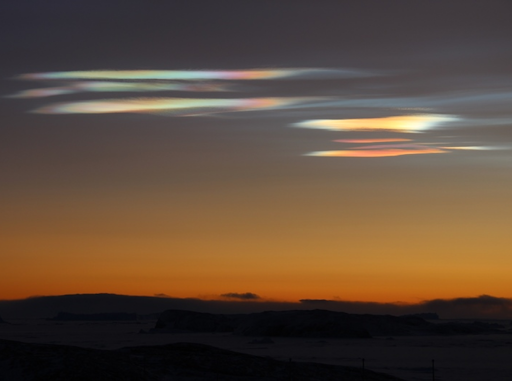
photo B. Sudarsan Patro
The clouds were absolutely stunning," says Patro. "It was really surprising and a new experience for all of us."
Atmospheric optics expert Les Cowley says "Bharati Station at 70 degrees south is just the place to get these wonderful filmy Polar Stratospheric Clouds (PSCs). Floating 9 to 16 miles high, they need stunningly-cold temperatures below -85 Celsius to form."
Sunlight shining through tiny ice particles ~10µm across produce the characteristic bright iridescent colors of PSCs by diffraction and interference. "More familiar tropospheric clouds can also shine with iridescent colours," says Cowley, "but never as vividly or memorably as PSCs.
Bron: http://www.spaceweather.com/ | Gewijzigd: 31 januari 2017, 15:57 uur, door Joyce.s
Polar stratospheric clouds
The stratosphere is a relatively clear layer of Earth's atmosphere, almost always cloud-free. Almost always. Yesterday, researchers at Argentina's San Martín Base spotted a bank of fantastically colored clouds floating in the stratosphere above the Antarctic Peninsula: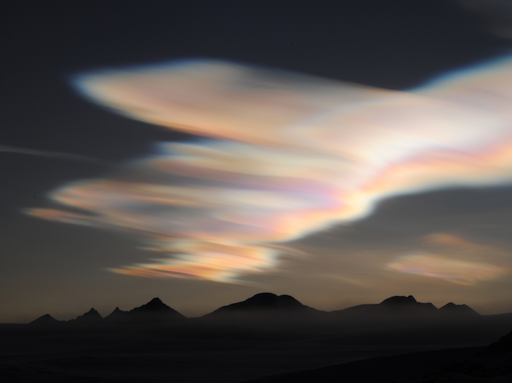
photo photographer "Marcelo,
"There were the biggest stratospheric clouds we've seen so far this year," says photographer "Marcelo," who is working at the Base this winter. "It was a colorful spectacle to begin the day."
These are called "Polar Stratospheric Clouds" (PSCs). They form in the lower stratosphere when temperatures drop to around minus 85º C. This explains why they are rare; even at the poles, such low temperatures are hard to achieve. High-altitude sunlight shining through tiny (~10µm) ice particles in PSCs produce bright iridescent colors by diffraction and interference. Once thought to be mere curiosities, some PSCs are now known to be associated with the destruction of ozone.
Apparitions of these clouds often persist for days. Stay tuned for more sightings from the frozen continent.
Bron: http://www.spaceweather.com/ | Gewijzigd: 31 januari 2017, 15:58 uur, door Joyce.s
Polar stratospheric clouds:
The stratosphere above the Arctic Circle is getting cold ... very cold. That's the only way to explain these colorful clouds that materialized over Kiruna, Sweden, on Dec. 9th:
photo photographer Mia Stålnacke
"Polar stratospheric clouds are back in the subarctic," reports photographer Mia Stålnacke. "They were brilliantly beautiful today."
Icy polar stratospheric clouds (PSCs) form in the lower stratosphere when temperatures drop to around -85ºC. That's how cold it has to be for ice crystals to form in the very dry stratosphere. High-altitude sunlight shining through tiny ice particles ~10µm across produce the characteristic bright iridescent colors.
"Once seen they are never forgotten," says atmospheric optics expert Les Cowley. "Polar stratospheric clouds have much more vivid colors than ordinary iridescent clouds, which are very much poor relations and seen frequently all over the world."
Once thought to be mere curiosities, some PSCs are now known to be associated with the destruction of ozone. Indeed, an ozone hole formed over the UK in Feb. 2016 following an outbreak of ozone-destroying Type 1 PSCs.
"Last winter we had these clouds almost daily for long periods of time," says Stålnacke. Arctic sky watchers are encouraged to be alert for more in the days ahead. The best time to look is just before sunrise or after sunset.
Bron: http://spaceweather.com/ | Gewijzigd: 31 januari 2017, 15:59 uur, door Joyce.s
Around the Arctic Circle, observers are reporting an outbreak of polar stratospheric clouds (PSCs). "Yesterday, Feb. 13th, the sky was filled with their brilliant colors from sunrise to sunset," says Mia Stålnacke, who sends this picture from Kiruna, Sweden:

©Mia Stålnacke
These clouds are newsworthy because normally the stratosphere has no clouds at all. Home to the ozone layer, the stratosphere is arid and almost always transparent. Yet, Stålnacke says, "we've been seeing stratospheric clouds very often this winter and last."
According to multiple longtime residents of the area, the Feb 13th display was exceptional. "Everyone I spoke to agrees it was the best they had ever seen," says Chad Blakley, who operates the Lights over Lapland tour guide service in Abisko, Sweden.
"I've been living here all my life (33 years)," says Stålnacke. "I definitely feel that these clouds are appearing more often then they used to. I remember seeing them a few times/year since I was a kid, but these last couple of years we've had them much more often--sometimes for almost a week straight. Others seem to feel the same way; I see local groups on Facebook flooded with photos of PSCs and comments on how often they're appearing now."
"The clouds were all over Finland, too," says Matti Helin who took this picture on Feb. 13th:
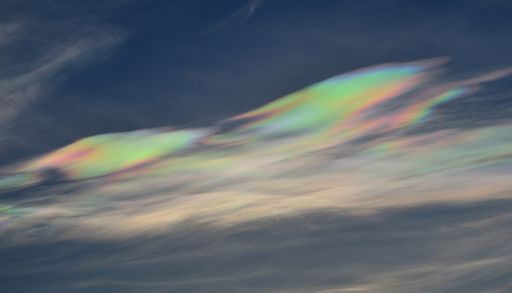
© Matti Helin
What's going on up there?
PSCs are a sign of very cold temperatures in the stratosphere. The clouds are made of ice. Indeed, that is the source of their remarkable color: High-altitude sunlight shining through tiny ice particles ~10µm across produce a bright iridescent glow. For ice crystals to form in the very dry stratosphere, temperatures must drop to around -85º C.
Once thought to be mere curiosities, some PSCs are now known to be associated with the destruction of ozone. Indeed, an ozone hole formed over the UK in Feb. 2016 following an outbreak of ozone-destroying Type 1 PSCs.
To investigate these clouds further, Spaceweather.com and the students of Earth to Sky Calculus will travel to Abisko Sweden for a week in March 2017. We plan to launch a series of space weather balloons into the Arctic stratosphere, measuring temperature, air pressure, and ambient radiation. If PSCs are present, our sensors will pass directly through them, and our cameras can photograph the colorful clouds at point blank range. Stay tuned!
Bron: http://spaceweather.com/
Arctic nights are usually colored by the aurora borealis. Last night was different. The colors came from polar stratospheric clouds (PSCs). Lars Lehnert photographed the display from Abisko, Sweden:
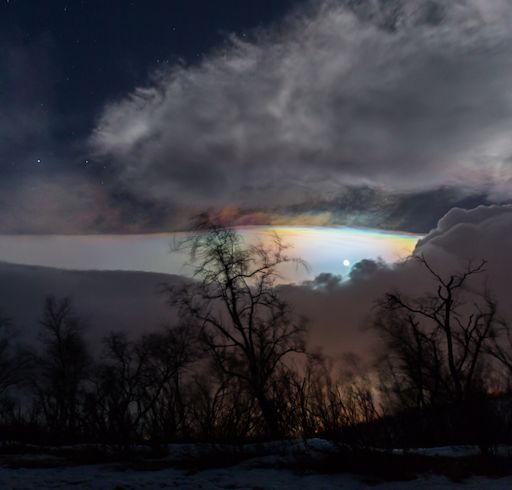
©Lars Lehnert
"We saw these clouds all day long," says Lenart, "and they continued into the night. I've never seen anything quite like it."
In Kiruna, Sweden, longtime PSC photographer Mia Stålnacke saw them, too: "This was a first for me!" she says. "The polar stratospheric clouds which lit up the Arctic skies in daylight are still here. Now they are beautifully lit up by the Moon instead!"
This is a remarkable episode of PSCs--the best in many years according to some longtime residents of northern Sweden. Arctic sky watchers should remain alert for more, both day and night, as this unusual winter continues.
Bron: http://spaceweather.com/
On Feb. 13th, something amazing happened in the stratosphere over the Arctic Circle. Normally, the air 60,000+ feet above Earth's surface is dry and utterly transparent. On the eve of Valentine's Day, however, the Arctic stratosphere filled with a gossamer haze of crystalline ice, and when sunlight hit the freezing crystals, the sky filled with clouds of intense iridescent color.
"Our guests referred to the clouds as 'daytime auroras,'" reports Chad Blakley, who operates the Lights over Lapland tour guide service in Abisko, Sweden. One of them, Champ Cameron (@champcameron on Instagram), snapped this picture of the display:
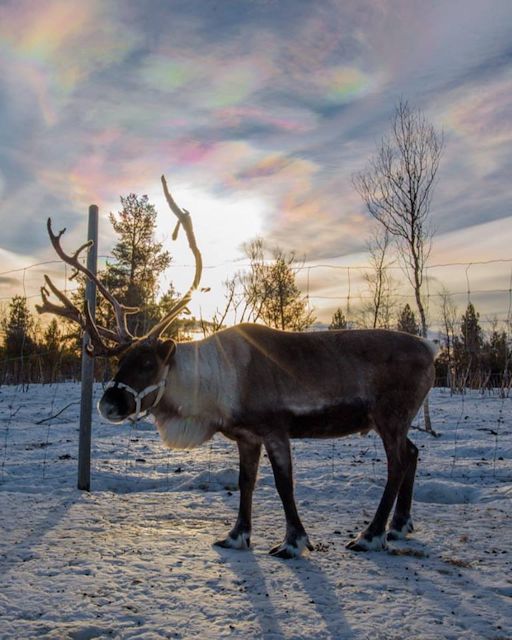
©Chad Blakley
"Champ was participating in our Sami And Reindeer Experience outside of Abisko yesterday afternoon," explains Blakley. "The roads were very icy due to a freak rain storm and warm weather (+9 degrees C) so we nearly canceled the trip. But we heard that there were incredible clouds in the sky so we chose to brave the weather and push on."
Good thing. They witnessed an exceptional display of polar stratospheric clouds (PSCs). PSCs are a sign of very cold temperatures in the stratosphere. For ice crystals to form in the normally arid stratosphere, temperatures must drop to around -85º C. So while it was strangely warm on the ground below, it was incredibly cold up above.
Longtime observers say PSCs are becoming more common and more intense. "I've been living here all my life (33 years)," says Mia Stålnacke of Kiruna, Sweden, who also photographed the colorful outbreak. "I definitely feel that these clouds are appearing more often then they used to. I remember seeing them a few times/year since I was a kid, but these last couple of years we've had them much more often--sometimes for almost a week straight. Others seem to feel the same way; I see local groups on Facebook flooded with photos of PSCs and comments on how often they're appearing now."
"Our bus driver, a longtime resident of the area, described it as the best PSC display he had ever seen," relays Blakley. "We were overwhelmed by the natural beauty." The clouds were so intense, they remained visible even after the sun set:

"We saw these clouds all day long, and they continued into the night," says photographer Lars Lehnert of Abisko, Sweden. " I've never seen anything quite like it."
Once thought to be mere curiosities, some PSCs are now known to be associated with the destruction of ozone. Indeed, an ozone hole formed over the UK in Feb. 2016 following an outbreak of ozone-destroying Type 1 PSCs.
To investigate these clouds further, Spaceweather.com and the students of Earth to Sky Calculus will travel to Abisko Sweden for a week in March 2017. We plan to launch a series of space weather balloons into the Arctic stratosphere, measuring temperature, air pressure, and ambient radiation. If PSCs are present, our sensors will pass directly through them, and our cameras can photograph the colorful clouds at point blank range. Stay tuned!
Bron: http://spaceweather.com/
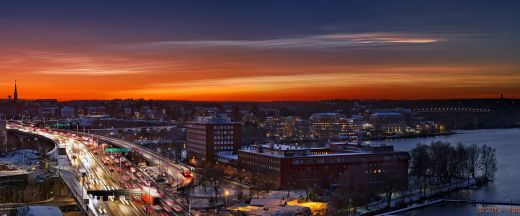
Peter Rosén
Polar stratospheric clouds are a sign that the Arctic stratosphere is getting cold. Very cold. They require temperatures around -85ºC to form.
The stratosphere is extremely dry, which makes it hard for clouds of any type to form. Only when the air up there becomes extremely cold do widely-spaced water molecules coalesce to form ice crystals--the "stuff" of PSCs. High-altitude sunlight shining through these ice particles produces the clouds' characteristic bright iridescent colors, as shown in this close-up from Peter Rosén:
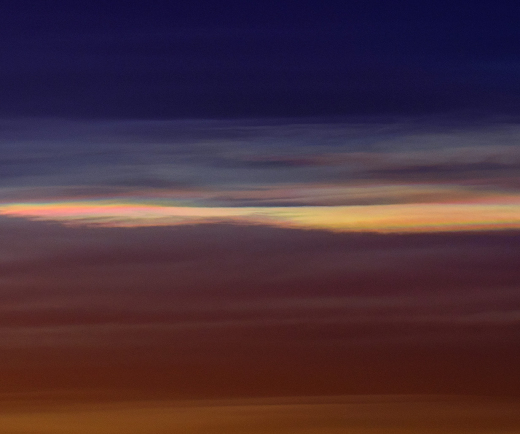
Peter Rosén
People who see them generally agree, they are the most beautiful clouds on Earth. "Polar stratospheric clouds far outshine and have much more vivid colours than ordinary iridescent clouds, which are very much poor relations and seen frequently all over the world," writes atmospheric optics expert Les Cowley. "Once seen they are never forgotten."
As the winter solstice approaches and plunges the northern stratosphere into deeper cold, these clouds will appear with increasing frequency.
Bron: spaceweather.com

 Polar stratospheric clouds
Polar stratospheric clouds




